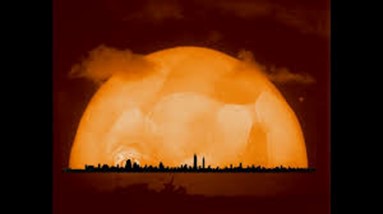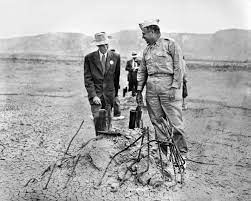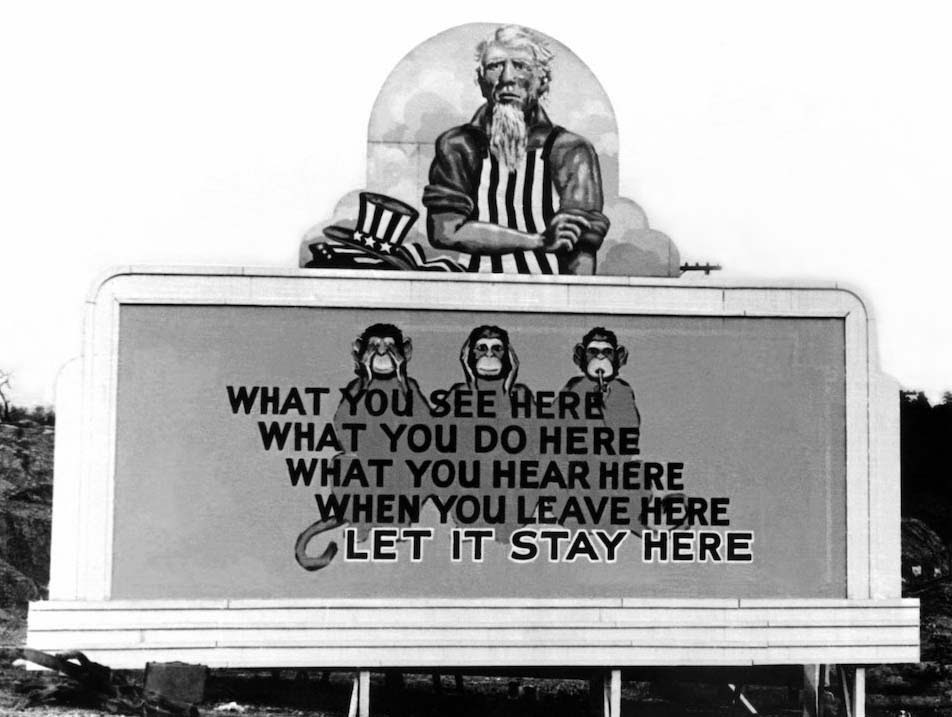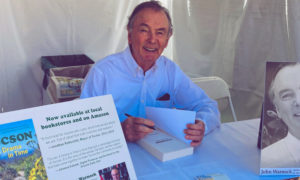A History of the Nuclear Age
“YOU MIGHT WANT TO KNOW”
By John P. Warnock

Welcome to the first in a series of columns about the people, places, issues, and, in general, darkly captivating history of the Nuclear Age, as written by John P. Warnock. John is a Tucson native and professor emeritus at the University of Arizona, where he taught English and writing. We are honored that he has agreed to share his work with PSR Arizona.
A prolific writer of books and articles on everything from Tucson history to acoustic guitars, John is also a chronicler of the world’s most important, and terrifying, scientific discovery: the splitting of the atom and the subsequent race to build the biggest and baddest bomb — and ushering in a global arms race framed around the MAD idea of deterrence by way of “mutual assured destruction.”
We will be publishing John’s columns every other week, beginning at the beginning with J. Robert Oppenheimer, the man at the center of the 20th century’s entry into the new world of warfare.
In our premier column, John sets up “the crucial distinction between the engineer and the scientist and the tension at Los Alamos around that. It’s a distinction that is greatly underappreciated in accounts of what was going on at Los Alamos.”
What did J. Robert Oppenheimer say after the first successful test of an atomic bomb on July 16, 1945? What did it mean?

J. Robert Oppenheimer, a physicist, was the Director of the Scientific Division of the Manhattan Engineering District at the secret Site Y in the Jemez Mountains of New Mexico. The MED was the project that the U.S. started in 1942, not long after entering World War II, to build an atomic bomb. In Tennessee and in Washington State, other sites in the Manhattan Project, as it soon came to be called, were tasked with producing the fissile fuel for the bomb. Site Y was tasked to design and test it.
On July 16, 1945, Oppenheimer and the scientists and engineers he successfully recruited to come to Site Y accomplished their task when they detonated in southern New Mexico, at what is now White Sands Missile Range, a plutonium implosion bomb that yielded the equivalent of 20+ kilotons of TNT.
Three years later, in an interview in Time magazine, and later in other venues, Oppenheimer said that after the Trinity test he “remembered the line from the Hindu scripture, the Bhagavad-Gita: Vishnu is trying to persuade the Prince that he should do his duty and, to impress him, takes on his multi-armed form and says, ‘Now I am become Death, the destroyer of worlds.’ I suppose we all thought that, one way or another.”
What he actually said right after the test, his brother Frank recalled, was “It worked.”

Knowledge Which Cannot be Forgotten
The people at Los Alamos had been motivated in their work in part by the fear that Germany would be the first to build such a bomb. But Germany had been defeated in May, two months before the bomb was successfully tested, three months before two bombs were dropped on Japan. During that time, the scientists and engineers at Site Y had been working just as hard, but why? We were still at war with Japan, but no one thought Japan would be able to build such a bomb before the war ended.
Ten years after World War II ended, Oppenheimer wrote in “The Open Mind” that the physicists who had worked on the bomb had, “[i]n some sort of crude sense which no vulgarity, no humor, no overstatement can quite extinguish,…known sin; and this is a knowledge which they cannot lose.”
Some of the physicists who had worked in the Manhattan Project demurred.
Though Oppenheimer never retracted this statement, he later showed that he himself was not haunted by any sense of guilt with respect to the atomic bombing of Hiroshima and Nagasaki. “I carry no weight on my conscience,” he said in 1961. “Scientists are not delinquents,” he added. “Our work has changed the conditions in which men live, but the use made of these changes is the problem of governments, not of scientists.
So what could he have meant when he said that the physicists had “known sin”?
The Nature of Sin
The sin might not have been in the making of the new kind of bomb, but, the physicist Freeman Dyson has suggested, in the fact that they had enjoyed doing it. And which of us would not have enjoyed it? Working all out in a beautiful place on a secret project that they believed was a life-or-death matter for the nation in the company of some of the world’s most brilliant people? What’s not to enjoy about that?
President Truman, who had the ultimate responsibility for deciding to use the bomb, had not enjoyed making that decision. If he had, he too would have known sin. But he hadn’t. Oppenheimer seems to have told Truman “I feel we have blood on our hands.” Truman later said he was a “cry-baby.” “He didn’t drop the bomb, I did,” Truman said.
Does this not show us something important about the nature of sin—that it can attach itself to our actions without our seeking it, without our even having any reason to think that sinning is what we are doing? And even if we don’t find, in the last analysis, that we did something we should not have done?
Einstein had declined the invitation to come work on the bomb (and for his pains become suspected by J. Edgar Hoover of disloyalty). But maybe even Einstein would have gotten caught up in the excitement had he been with the other brilliant and dedicated people at Site Y. And, with the others, known sin.

In Retrospect
“Despite the vision and the far-seeing wisdom of our wartime heads of state, the physicists felt a peculiarly intimate responsibility for suggesting, for supporting, and in the end, in large measure, for achieving the realization of atomic weapons. Nor can we forget that these weapons, as they were in fact used, dramatized so mercilessly the inhumanity and evil of modern war. In some sort of crude sense which no vulgarity, no humor, no overstatement can quite extinguish, the physicists have known sin; and this is a knowledge which they cannot lose.” – J. Robert Oppenheimer, The Open Mind (1955)
